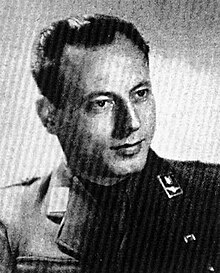Ante Vokić
This article has multiple issues. Please help improve it or discuss these issues on the talk page. (Learn how and when to remove these template messages)
|
Ante Vokić | |
|---|---|
 | |
| Minister of Armed Forces of the NDH | |
| In office 29 January 1944 – 8 August 1944 | |
| Prime Minister | Nikola Mandić |
| Preceded by | Miroslav Navratil |
| Succeeded by | Nikola Steinfl |
| Minister of Transportation of the NDH | |
| In office 11 October 1943 – 30 August 1944 | |
| Prime Minister | Nikola Mandić |
| Preceded by | Hilmija Bešlagić |
| Succeeded by | Jozo Dumandžić |
| Personal details | |
| Born | 23 August 1909 Mostar, Austria-Hungary |
| Died | 8 May 1945 (aged 35) Lepoglava Prison, Lepoglava, Independent State of Croatia |
| Cause of death | Execution by firing squad |
| Nationality | Domobranstvo Ustaše Army |
Ante Vokić (23 August 1909 – 8 May 1945) was a
Vokić was one of the leaders of the 1944 Lorković–Vokić plot, an attempt to align the country with the Allies and against the Axis powers. After the plot was uncovered, Vokić was arrested and later executed.
Biography
Youth
Vokić was born in Mostar on 23 August 1909. He attended a gymnasium in Sarajevo and studied law at University of Zagreb. He ended his studies in 1929 and started working for the train service in Sarajevo. He co-founded the Croatian Academic Club Kranjčević and the newspaper Svijest (Consciousness) and participated in the HKD Napredak.[1]
World War II
Before the establishment of the Croatian state, Vokić was a member of the Ustaše branch in Zagreb.[1] On 11 April 1941, by order of Slavko Kvaternik, he was sent to serve at headquarters of the newly formed Ustasha Surveillance Service, whose main task was to lead and build up existing Ustaša combat formations and form new ones.[2] Later that year he was appointed Director of Train Services in Sarajevo. He was an organising commander of all Ustaša traffic brigades.[1] As an associate of Jure Francetić, he was a founding member of Black Legion, an infantry unit of Ustaše Militia.[3] In 1943, he left Sarajevo and moved to Zagreb and on 11 October of that year he was appointed Minister of Transportation and Public Works.[1][4]
On 29 January 1944, he was promoted to the Ustaše rank of
Lorković–Vokić plot
This section needs additional citations for verification. (June 2016) |

Together with Mladen Lorković, Vokić led a coup dubbed the
He received support from the Domobran officers and lost favour with the Ustaše, who were loyal to Ante Pavelić. He contacted Ivan Faroli, lawyer for Vladko Maček, the president of the Croatian Peasant Party. He informed Faroli about a coup to bring down the Ustaše and give power to the Croatian Peasant Party. This included the replacement of Ustaše's officers with Domobran officers, loyal to the Croatian Peasant Party and disarmament of German units on Croatian territory.
Later[
Vokić's friend, Ante Štitić, a high ranking police official who was also involved in the coup, wrote a report after meetings with Lorković (24 August 1944) and Vokić (25 August 1944). He handed the report to the Ustaše units commander, Ivo Herenčić, an old opponent of Vokić. Herenčić gave the report to Pavelić. That report was the main evidence presented against Vokić and Lorković at their trial for "high treason".[citation needed]
Death
At a sudden government assembly on 30 August 1944, Vokić and Lorković were accused of conspiring against Pavelić and his Croatian allies, mainly Nazi Germany. They were removed the same day from their duties and placed under house arrest. Lorković and Vokić were brought in front of Poglavnik's Bodyguard Unit court. They convicted him, stripped him of his rank and expelled him from the unit. He was later interned in
References
- ^ a b c d e Ravlić 1997, p. 417.
- ^ Jelić-Butić 1977, pp. 76.
- ^ Yeomans 2013, p. 27.
- ^ Yeomans 2013, p. 22.
- ^ Marković, Marko. Jure i Boban - Povijest Crne legije, Zagreb, MBF Publishing (2003)[self-published source]
Sources
- Jelić-Butić, Fikreta (1977). Ustaše i Nezavisna Država Hrvatska 1941–1945 [Ustaše and the Independent State of Croatia 1941–1945] (in Serbo-Croatian). Liber.
- ISBN 978-953-6377-03-9.
- ISBN 0-8047-3615-4.
- Yeomans, Rory (2013). Visions of annihilation : the Ustasha regime and the cultural politics of fascism, 1941–1945. Pittsburgh, United States of America: University of Pittsburgh Press. ISBN 978-082-2961-92-5.
